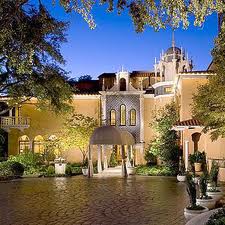Once again I found myself staring at a classic wine list, this time at the Mansion on Turtle Creek in Dallas, that was deep in severely marked up classic Bordeaux, Burgundy, and California Cabernet. Looking for an after dinner bottle to enjoy with some colleagues did not call for $300 California Cabernet, $600 Burgundy, nor $1,000+ Bordeaux. As usual, I took cover and turned to the back of the list in search of values under $100 from less venerable regions of France, Italy, and Spain. The hunt turned up one of the most remarkable wines I have ever tasted from the Côtes du Roussillon: (****) 2002 Calvet-Thunevin Hugo. The wine sat on the list for roughly $80, an intense value with recent vintages retailing for approximately $40.
Years ago, Robert Parker tagged Jean Luc Thunevin the “bad boy” of St. Emilion for his in your face, old-world-Bordeaux-busting garage production of Chateau Valandraud. If you want to drink the post-Parker rave 2005 Valandraud, for example, you will part with a few hundred dollar bills at retail and approach a $1,000 tab on wine lists similar to the Mansion’s. Thank you Monsieur Parker. Alternatively, I have been buying the Calvet-Thunevin Cuvee Constance, Thunevin’s Languedoc project in partnership with local winemaker Jean Roger Calvet. It’s a blend of primarily carignan and grenache that is aged in concrete tanks That wine regularly sells for less than $15 and belies its concrete upbringing delivering character, depth, richness, class, nuance, regional authenticity, herbs, and intensely deep fruit without any hard carignan edges. I drink it with special meals, and I drink it with hamburgers; it’s that versatile and worthy.
 Picking the 2002 Calvet-Thunevin Hugo for under $100 on the Turtle Creek Mansion was not only the right move, but it showed an ever more riveting side to the Calvet-Thunevin project. Old vine grenache (60%), syrah (30%), and carignan (10%) is aged in large wood vats for 18 months before bottling without any fining or filtration. While 2002 was not an ideal vintage for French vignerons, the Hugo not only defied the tales of vintage woe, but also aged gracefully over the nine years since harvest. It is demonstrating a transition from its deep dark color with touches of amber on the edge, and when you stick your nose anywhere near the glass it smells like somebody just opened a bag of Twizzlers black licorice nibs. With closer inspection the anise aromas blend equally with wafts of tobacco leaf. Medium tannins integrate for full appreciation of the elegant mouthfeel delivering muted kirsch grenache deliciousness and spicy syrah without any trace of astringency. It is simply a mind blowing wine complete with advanced aromatics and flavor, solid fruit, and lots of life ahead of it.
Picking the 2002 Calvet-Thunevin Hugo for under $100 on the Turtle Creek Mansion was not only the right move, but it showed an ever more riveting side to the Calvet-Thunevin project. Old vine grenache (60%), syrah (30%), and carignan (10%) is aged in large wood vats for 18 months before bottling without any fining or filtration. While 2002 was not an ideal vintage for French vignerons, the Hugo not only defied the tales of vintage woe, but also aged gracefully over the nine years since harvest. It is demonstrating a transition from its deep dark color with touches of amber on the edge, and when you stick your nose anywhere near the glass it smells like somebody just opened a bag of Twizzlers black licorice nibs. With closer inspection the anise aromas blend equally with wafts of tobacco leaf. Medium tannins integrate for full appreciation of the elegant mouthfeel delivering muted kirsch grenache deliciousness and spicy syrah without any trace of astringency. It is simply a mind blowing wine complete with advanced aromatics and flavor, solid fruit, and lots of life ahead of it.
One of my favorite wine writers, Levi Dalton, just wrote about how to navigate a wine list at his blog So You Want To Be A Sommelier. It is replete with tips from years of experience on both sides of wine lists- buying and selling. Two of his tips include buying the cheapest wine on a really good wine list (it’s probably one of the sommelier’s favorite finds), and starting from the back of the list and working forward. Both of these rules were applied to the selection process of this Calvet-Thunevin wine. It works, give it a try.
